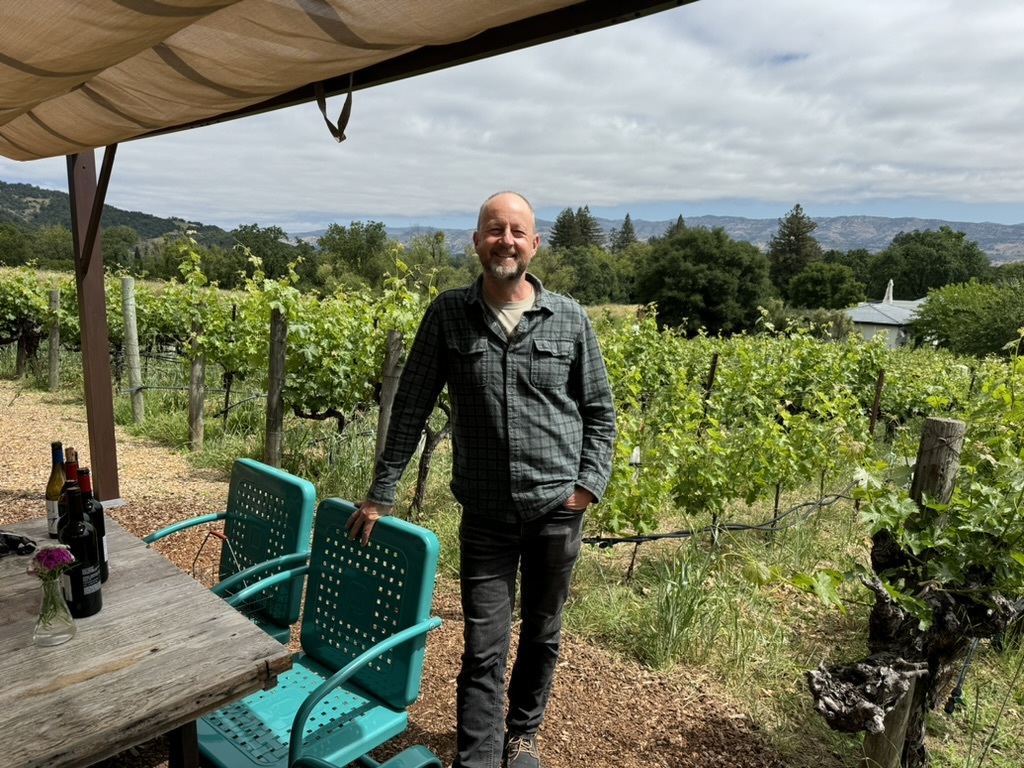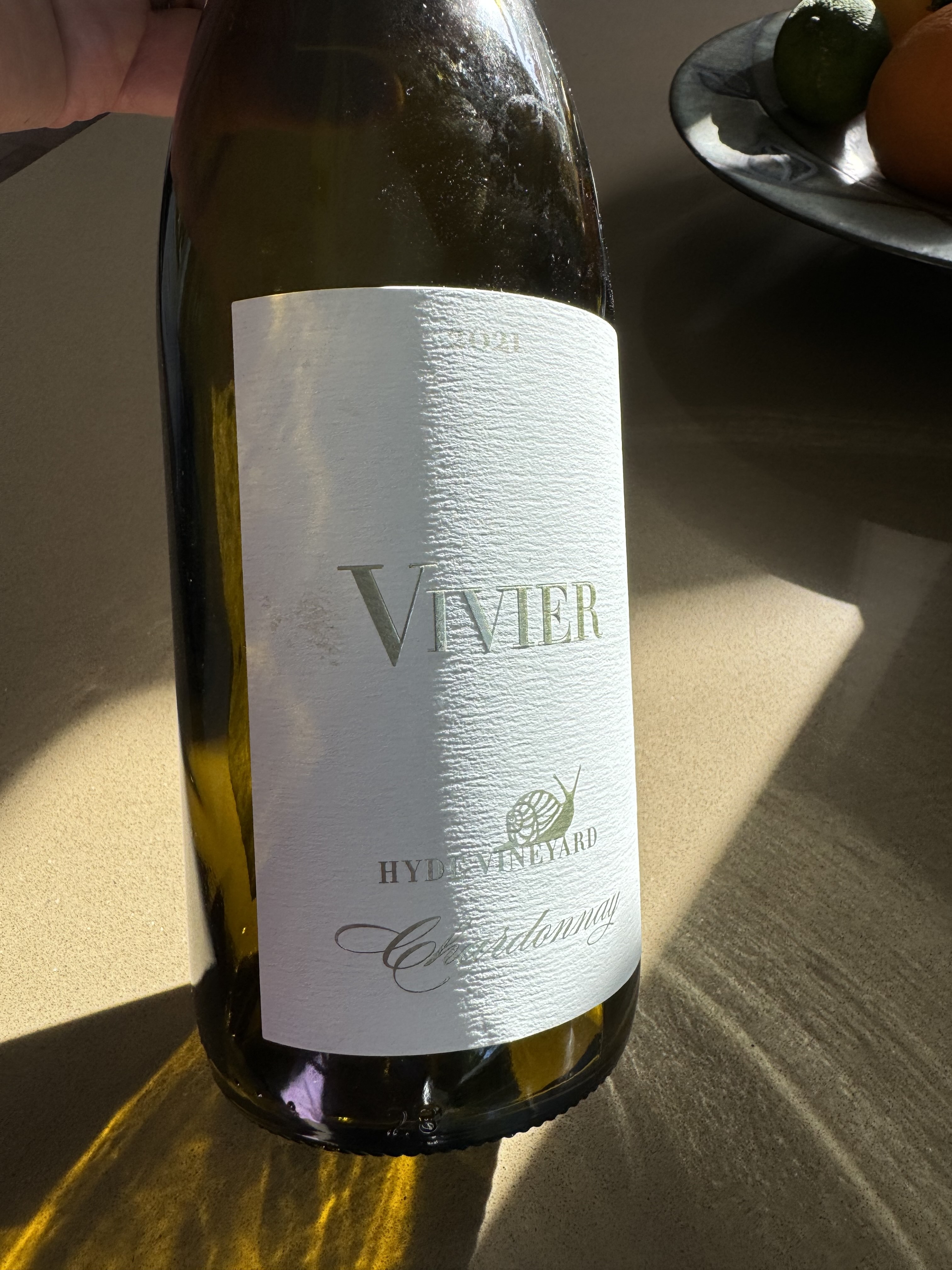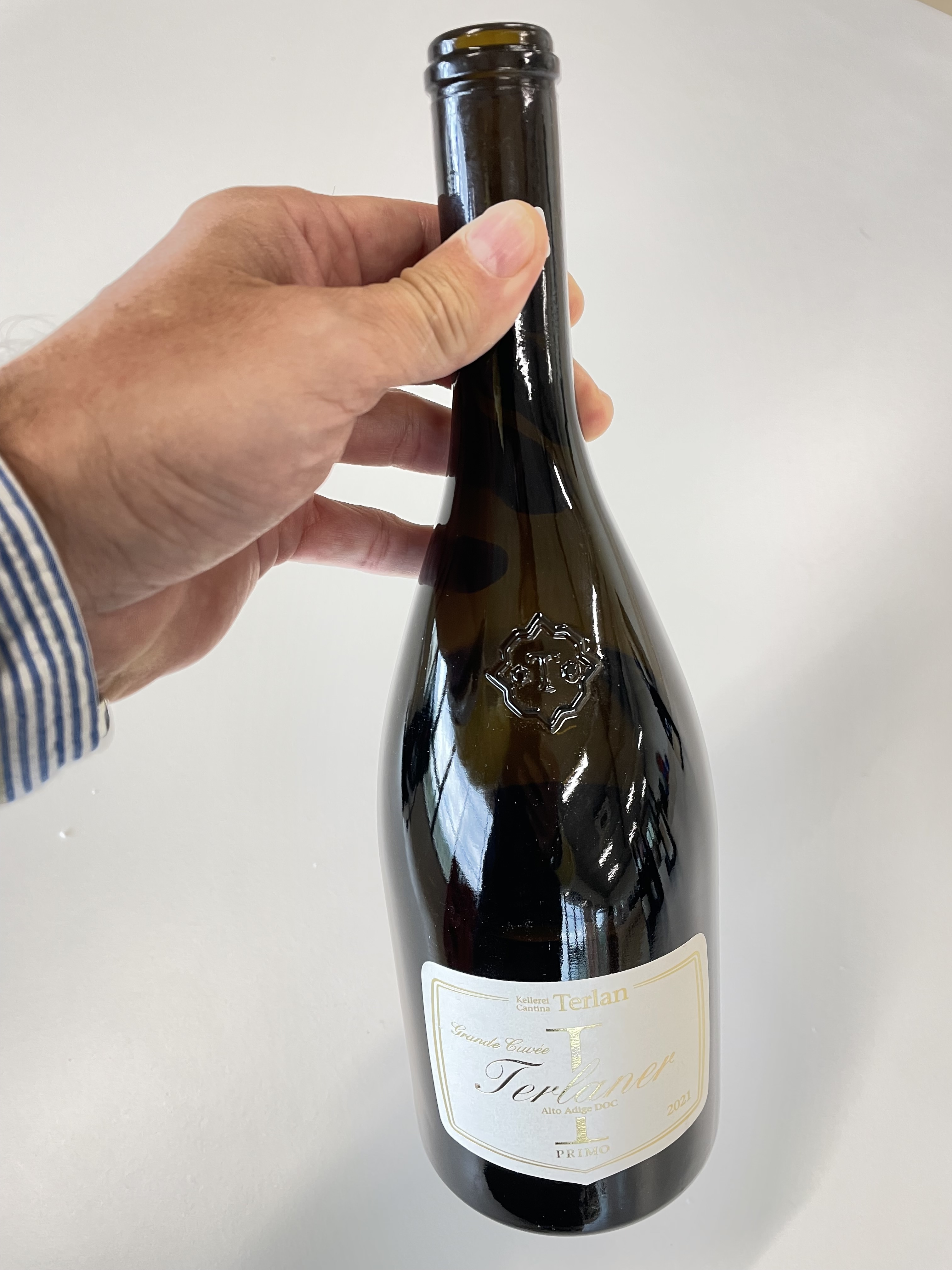
A distinct minority of producers in Northern California has been leading the way for years to dramatically more linear, fresh wines with exciting tension. Executive Editor Jim Gordon tasted a slew of great examples of these for this week’s report, including from Stephane Vivier, Steve and Jill Matthiasson and Randall Grahm, who has been tilting at the windmills of California wine orthodoxy since the 1980s.
Take the sleek and stony Vivier Chardonnay Napa Valley Carneros Hyde Vineyard 2021 as a shining example of the beauty to be found in a little restraint. Harvested early for great acidity and lower alcohol, this wine still displays the richness and depth for which Larry Hyde’s Napa-Carneros vineyard is rightly famous. Lemon blossoms, lemon curd, white peaches, vanilla bean, mineral nuances and a precise, linear expression make it memorable, and it’s age-worthy too.


The 2022 version of the same Vivier Hyde Chardonnay is almost as enticing: light, poised and laced with lemon curd and hazelnuts. Vivier’s chardonnays from Van Der Kamp Vineyard and Gap’s Crown are outstanding in quality and balance as well.
Speaking of Van Der Kamp, this exceptional vineyard in the Sonoma Mountain American Viticultural Area ranks among the oldest pinot noir properties in the state. The current vines were planted in 1952, and under Stephane Vivier’s care they produced a rather full-bodied, complex Vivier Pinot Noir Sonoma Mountain Van Der Kamp Vineyard 2021 that is generous in floral, rosemary, mushroom and star anise flavors. It’s the highest-rated California pinot in this report. The Vivier Pinot Noir Sonoma Mountain Van Der Kamp Vineyard 2022 is also impressive but shows a lighter color and more tangy red fruits, like cranberry and cherries.
Any discussion of restraint, acidity and freshness in Napa Valley wines has to include Matthiasson, whose acid-driven, low-alcohol wines have a cult-like following among wine trade members and a dedicated set of consumers. Steve Matthiasson was a respected viticulturist and vineyard manager before starting a winery and helping write the Lodi Rules, which became the basis for California’s statewide standards for certified sustainability in grape growing.
Matthiasson harvests earlier than most for his own wines, bringing in the grapes before their acidity drops and sugar content rises to what many call full ripeness. He says that for red wines he doesn’t want dried fruit or stewed fruit flavors, but fresh, crisp fruit flavors that remind him of the natural vivacity of farmer’s market produce. His white wines have very lean, racy textures that wow his core consumers.
The Matthiasson Chardonnay Napa Valley Linda Vista Vineyard 2022 is a great example. This light-bodied beauty was barrel-fermented with native yeast, went through partial malolactic for a touch of butter, but a mouthwatering, tangy texture and green-apple fruitiness give it great freshness. Even racier is the Matthiasson Napa Valley White Wine 2021, a blend of sauvignon blanc, semillon, his signature grape ribolla gialla and a smidgeon of tocai friuliano. It’s light, subtle, mineral-like and so tangy.
Unusual grape varieties are a specialty of Matthiasson, and they give his wine club interesting, eclectic choices from Napa and Sonoma sites like the reds from pinot meunier, refosco and schiopettino, and the whites from vermentino, scheurebe and ribolla gialla. He makes the latter as an orange wine, fermented with the skins to give it some of the heft and tannin of a red. The Matthiasson Ribolla Gialla Napa Valley Matthiasson Vineyard 2021 offers a grippy, tooth-drying texture that’s super energizing.



It might be surprising that Matthiasson also makes outstanding Napa cabernet. but he does. His Cabernet Sauvignon Napa Valley Phoenix Vineyard 2021 was the best of six tasted, with a light body under 13 percent alcohol, great acid balance, delicious red cherries, blackcurrants, bay leaves and baked earth nuances. It needs a few years to show its best side.
Jim also tasted and rated highly four of Randall Grahm’s Language of Yes wines, which were made in a partnership with the E. & J. Gallo Winery from Rhone grape varieties grown along California’s Central Coast. The name displays Grahm’s lifelong penchant for wordplay, as it translates the name of France’s southwest vineyard region, the Languedoc, in a literal way. He explains that “langue” means language, of course, and “doc” is an abbreviation of “d’oc,” which means “of yes” because oc in the old vernacular of the region meant oui or yes.
And yes, The Language of Yes Syrah Central Coast En Passerillage 2022 is a brilliant, cool-climate wine that’s light-bodied, peppery and fresh. Grahm fermented it with 50 percent whole clusters and included 18 percent viognier grapes. Another unusual touch is that a portion of the syrah was harvested, then laid out to air dry for a few days before beginning fermentation. Grahm’s two other Rhone-style reds and a rosé also show light bodies, snappy textures and great acid balance.

THE FRANKEN REVOLUTION
Senior Editor Stuart Pigott was amazed by what he found when he travelled to the underrated Franken wine region of Germany, which has struggled to be taken seriously internationally in part because it focuses on dry wines from the silvaner grape instead of on riesling like the more famous regions of the Mosel and Rheingau or even Rheinhessen and the Pfalz.
Silvaner from Franken used to frequently be described by experts as rustic and/or earthy, and at the end of the 20th century those were sometimes appropriate descriptors. Stuart has been following the Franken revolution in silvaner winemaking and another in varietal diversification since they began around the turn of the century, but even he was stunned by the brilliance of the best wines he tasted.
The most dazzling of them was the Luckert Silvaner Franken Creutz Trocken *** 2023, the most extraordinary Silvaner Stuart has ever encountered. The flinty minerality of this enormously concentrated Silvaner is off the scale, and it has great purity and finesse at the almost endless finish. Almost as breathtaking is the Luckert Silvaner Franken Maustal GG 2023, a giant of silvaner elegance, although it is only medium-bodied, but with a great chalky and flinty intensity at the super-long and focused finish.
Uli Luckert doesn’t just produce limited-edition masterpieces. His row of entry-level wines sold under the Sulzfelder village designation – Sulzfeld being the town where the winery is based – are also stunning. Scroll down through the notes below to find all these friendly-priced gems.
Rudi May of the May winery, situated just north of the region’s historic capital city of Wurzburg, has done more than any other Franken winemaker to push the envelope with silvaner in recent years. Stuart attended the launch of his new ultra-premium May Silvaner Franken Kniebrecher 2022, which was bottled in March after 18 months of maturation in well-used barrique casks.
This wine deftly walks the tightrope of marrying oak with the restrained fruit (think candied citrus) aromas of silver plus a forthright minerality. It is a 50/50 blend of the best lots of wine from May’s contrasting GG sites – Himmelspfad with its limestone soil and Rothlauf with its red sandstone.
Riesling has long been only a specialty in Franken, and one of the problems for this grape in the region was that the wines from some of the famous-name vineyards frequently underperformed. This makes the return of the legendary Pfulben site to the spotlight big news. The wine in question is the Bürgerspital Riesling Franken Pfülben GG 2022, a dry riesling with an unbelievable nose of all the colors of peach plus fresh pineapple.

There’s quite a history behind this wine, with Burgerspital’s director, Robert Haller, having replanted this vineyard in 2010 with a massale selection (non-clonal) of riesling from Alsace in France. This was a daring choice that swam against the stream of accepted practice, which would have demanded a well-known German clone. It’s a great example of how Franken is way more dynamic than widely supposed. And the wine proves Haller was right to stick his neck out! As you can see below, there are a bunch of other excellent wines in Burgerspital’s current range, particularly in the single-vineyard GG and Erste Lage (EL) categories.


The western part of Franken, called Churfranken, has a long red wine tradition and is home to some of Germany’s best producers of spatburgunder, or pinot noir. The Furst winery is the shining star among them and the 2022 vintage is the best ever for Sebastian Furst. The Fürst Spätburgunder Franken Hundsrück GG 2022 is one of his most elegant pinots in a long time, with breathtaking aromas of wet earth, autumn leaves, mint and smoke overlain by layers of red fruit. It’s only medium-bodied but extremely concentrated with a very filigreed finish. The Fürst Spätburgunder Franken Schlossberg GG 2022 is almost as amazing, but more fragrant with a compelling harmony and almost endless finish of great delicacy.
The Furst family has a reputation for racy and very mineral dry riesling, and the Fürst Riesling Franken Centgrafenberg GG 2023 lives up it spectacularly. The complex aromas of yellow fruits, wild herbs and berries lead you into a diamond bright and sleek palate. Like the winery’s reds, this should age magnificently.
Perhaps because his winery is located in a non-vineyard location in Franken, surrounded by fields of wheat, enfant terrible winemaker Christian Stahl is the champion of varietal diversification and new winemaking styles in the region. Several of his important new wines, such as the chenin blanc and two single-vineyard scheurebe, were still in cask, which meant that the standout wines here were a chardonnay and a sauvignon blanc.

The Stahl Chardonnay Franken Sonnenstuhl 2022 has deep aromas of lemon curd and Mirabelle plums with terrific leesy and flinty complexity. It has the kind of structure, length and precision we expect from Burgundian Premier Cru wines. No less stunning is the vibrant Stahl Sauvignon Blanc Franken Felswand Trocken 2022 with its fabulous interplay of fresh papaya and flinty character. The racy acidity and stony minerality drive the very long finish.
The other extraordinary thing about Stahl is his second career as one of the two chefs in his eponymous restaurant. Together with his kitchen partner, Mirko Schweiger, Stahl recently gained a Michelin star. Both are self-taught, which is very rare in top restaurants anywhere in Europe. Where else in the world is there a leading winemaker who is also a leading chef?
However, trouble is afoot in Franken. As in Germany’s other 12 wine regions, all wines have to pass a tasting test to be allowed to put the region’s name on the label. Unfortunately, many of the above winemakers are finding it increasing difficult to clear that hurdle, and several of them said they may be forced to stop using the regional name. It seems that many members of the tasting panel cannot understand wines made with long-term aging potential. This problem also affects young winemakers like Philipp and Kilian Giegerich, who Stuart regards as important rising stars. We will report further as this story unfolds.

QUINTESSENTIAL ITALIAN WHITES
It often happens when traveling and tasting in wine regions that the same two or three producers in any one area stand out the most, and it was no different in James’ and Senior Editor Aldo Fiordelli’s recent tastings of Italian white wines. Aldo believes that soil is the element that never betrays in tasting, surpassing the winery’s style, the vintage, and with aging even the grape variety. Limestone, clay and sand each have their own stamps, but the concept of terroir also includes the interpretation of the viticulturist.
One wine Aldo tasted where the terroir and viticulture work shine through is the Marchesi Antinori Umbria Cervaro della Sala 2022. It’s a blend of chardonnay and grechetto, a noble grape allied to a native Umbrian variety that is as typical as it is rustic and prone to oxidation. Over the years, Antinori has reduced the percentage of grechetto in favor of chardonnay, meticulously working the vines and adjusting harvest times to achieve purity in bottle. The latest vintage is a great example of freshness and verticality, not lacking in toasted complexity – a Burgundian wine from central Italy.
While Antinori elevates the southern traits of Umbria, Francesco Paolo Valentini has brought the wild Abruzzo region to the fore with his trebbiano wines, which are citrusy, savory, light and elegant. His Valentini Trebbiano D’Abruzzo 2020 is bone dry on the palate with zesty acidity, and flavorful tangy and electric at the end.
But some of Italy’s most extraordinary whites come from Cantina Terlano in Trentino-Alto Adige. Although Cantina Terlan’s Alto Adige Terlaner Rarity 2011 demonstrates the often-underrated longevity potential of Italian whites and its Vorberg Riserva 2021 is one of the most mineral expressions from Alto Adige, the Terlaner 1 2021 is a masterpiece of concentration, complexity and finesse – an Italian version of a Corton-Charlemagne. A couple of other wines to check out from Trentino Alto-Adige are the Sauvignon Blanc Tannenberg 2022 from Manincor and the biodynamic wines of Elisabetta Foradori, particularly the Fuoripista 2022, a slightly macerated pinot grigio that is the quintessence of the variety.
– Jim Gordon, Stuart Pigott and Aldo Fiordelli contributed reporting.
The list of wines below is comprised of bottles tasted and rated during the past week by James Suckling and the other tasters at JamesSuckling.com. They include many latest releases not yet available on the market, but which will be available soon. Some will be included in upcoming tasting reports.
Note: You can sort the wines below by country, vintage, score and alphabetically by winery name. You can also search for specific wines in the search bar.




